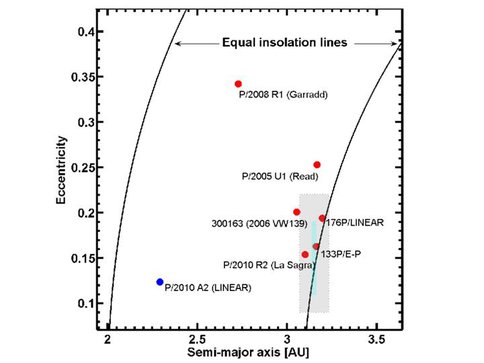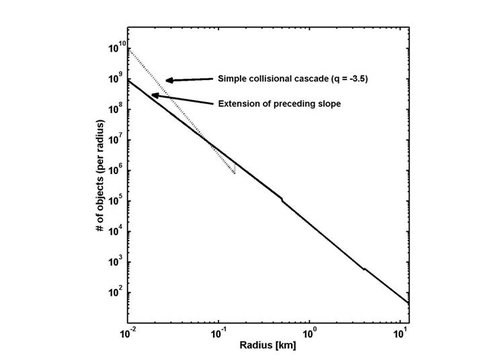2012 Annual Science Report
 University of Hawaii, Manoa
Reporting | SEP 2011 – AUG 2012
University of Hawaii, Manoa
Reporting | SEP 2011 – AUG 2012
Main Belt Comets and Water in the Outer Asteroid Belt
Project Summary
The ongoing discovery of potential members of a new class of objects, known as Main Belt Comets (MBCs), raises a number of questions regarding their structure, composition, and origin. These may indicate that the entire outer asteroid belt contains significant volatile material, and this has impli-cations for its delivery to the terrestrial planets. Whatever the origin is, they have spent most of their lifetimes in the asteroid main belt, which has been considered too hot for ice to survive for any length of time. The low conductivity of porous cometary material suggests, however, that ice may be retained in the interior of main belt bodies, despite continual solar heating. Indeed, analytical estimates, as well as numerical computations, indicate that this is possible. We investigate the ice survival question by means of detailed numerical modeling of long-term evolution for a range of ini-tial parameters. As another step in this study, we try to characterize the impact-triggering mecha-nism that supports the observed activity, however diffuse and weak it may be. This is achieved by means of statistical estimates of how a population of very small colliding bodies will ablate the sur-face and affect the way heat is conducted into any deeper buried water ice pockets. The main ques-tions that we address are: (a) To what extent and under what conditions (related to structure and composition) may water ice be preserved in MBCs for the age of the Solar System; (b) How deep below the surface is the ice expected to be found? (c) What is the rate at which small impacts ex-pose fresh water ice pockets and cause it to sublimate?
Project Progress
We have completed the first part of the project, namely the initial parameter study of ice survival, under the surface of objects akin to known MBCs. In this study we investigate water ice longevity in the interior of small objects in the asteroid belt. We considered bodies of 0.15 to 2.5 km in radius (following the population of identified MBCs), composed of water ice and dust (in abundances common for comets and estimated for C-type asteroids). We also adopt two different density values (deduced from observations of Jupiter-family comets and C-type asteroids) and two limiting cases of heliocentric distances, following the known orbital distributions of C-type asteroids and MBCs.
We find that large bodies (up to a few km in diameter) may retain ice over the age of the Solar System even at shallow depths of the order of 50 m. Smaller bodies in the inner belt, on the other hand, may lose their ices. Members of Collisional families, which may be much younger (as is likely for the currently observed objects), are more likely to have ice at depths as shallow as 10-20 m, accessible to activation by collisions.
The issue of actual activation by such collisions, due to a population of small impactors, is under cur-rent investigation. We have compiled a reasonable representation of such an impactor population (constrained by existing observations of the small asteroid population) and are in the process of estimating its effect. This is achieved by applying several impact scaling laws to a suite of impact configurations, which parameterize both the impactor and the impacted surface. Our next step will be to derive the relation between the impact depths (or mass loss volumes) and the rate at which these depths can become accessible, due to the size distribution of impactor bodies.
MBCs in the semi-major axis vs. eccentricity plane. Lines of equal total orbital insolation are shown as solid curves. Filled circles represent the orbits of the known objects, with P/2010 A2 differing in color, as its activity may be of a different nature than the other MBCs and is most likely a result of a recent massive collision. The shaded regions mark the boundaries of the current Themis (gray) and Beagle (cyan) asteroid families. These represent objects that have been emplaced in these orbits at later times.
Size-frequency distribution (SFD) of small asteroids, as representing the population of small impactors. The slopes for the different size ranges were compiled from various surveys of S-type and C-type asteroids smaller than about 10 km. For objects smaller than about 150 m, we consider a simple continua-tion of the same SFD, or a more steep esti-mate of collisional grounding, down to sizes of a few meters.
Publications
- Sarid, G., Prialnik, D. & Meech, K.J. (2012, Under Revision). Survival of Ice in Main Belt Comets – A Parameter Study. Monthly Notices of the Royal Astronomical Society.
-
PROJECT INVESTIGATORS:
-
PROJECT MEMBERS:
Gal Sarid
Project Investigator
Brendan Hermalyn
Co-Investigator
Karen Meech
Co-Investigator
Dina Prialnik
Co-Investigator
-
RELATED OBJECTIVES:
Objective 1.1
Formation and evolution of habitable planets.
Objective 2.2
Outer Solar System exploration

